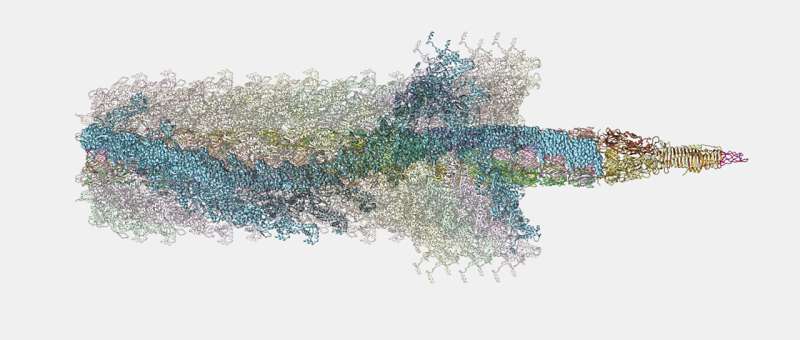Bacterial nanosized speargun works like a power drill

In order to get rid of unpleasant competitors, some bacteria use a nanosized speargun. Researchers at the University of Basel's Biozentrum have gained new insights into the construction, mode of action and recycling of this weapon. As they report in the journal Nature Microbiology, the speargun drills a hole into the neighboring cells in only a few thousandths of a second and injects a cocktail of toxins.
Millions of tiny microbes on leaves, stones or our skin jostle for space. And almost everywhere, they have to compete for resources and nutrients. In the course of evolution, some bacteria have therefore developed a weapon to inject a toxic cocktail into competitors and rivals, thus eliminating them. This weapon, resembling a speargun, is called the type VI secretion system (T6SS).
Two years ago, Prof. Marek Basler determined the atomic structure of the speargun in the "post-firing" state. In the current study, his team has solved the structure of the "ready to fire" speargun. Based on these findings, the researchers have modeled how the T6SS speargun works. It is composed of components including a sheath and a spear with a sharp tip. The sheath consists of over 200 connected, cogwheel-like protein rings that are assembled around the inner rigid spear. When T6SS fires, the sheath rapidly contracts and pushes the toxic spear out of the cell, which can then penetrate into neighboring cells where it releases deadly toxins. "So far, there have only been assumptions as to how the structure of the T6SS sheath changes during contraction," says Basler. "Using cryo-electron microscopy available at C-CINA, we have now obtained an image of the spear and the extended sheath in atomic resolution."
By comparing the structures of the extended and contracted states, the researchers modeled how the T6SS works in detail. "During the sheath contraction, ring after ring turns and gets closer to the previous ring, while the ring diameter expands and thus releases the spear," explains Basler. "This combination of sheath shrinking and turning results in drilling a hole into the target cells. In less than two milliseconds, the T6SS sheath contracts to half of its length and at the same time, the toxic spear spirals out like a screw. Therefore, the bacteria have an extremely powerful drill."
After firing T6SS, the bacteria re-use the individual components of the sheath to assemble a new speargun. "For a long time, it was not clear why only the contracted sheath is disassembled, but the extended sheath is not," says Basler. "Now, we could see that a certain protein domain is exposed on the surface of the sheath during contraction and can be recognized by a specific protein responsible for dismantling the sheath. In the extended sheath state, this domain is hidden, and the T6SS sheath is therefore protected from disassembly."
The researchers will continue studying the speargun. "One of our projects is dedicated to the question of how the T6SS is embedded in the bacterial cell envelope. As the speargun is fired with such a high force, it must be firmly anchored—otherwise, firing would not work properly, or could even kill the weapon-carrying bacteria themselves."
More information: Jing Wang et al, Cryo-EM structure of the extended type VI secretion system sheath–tube complex, Nature Microbiology (2017). DOI: 10.1038/s41564-017-0020-7
Journal information: Nature Microbiology
Provided by University of Basel



















